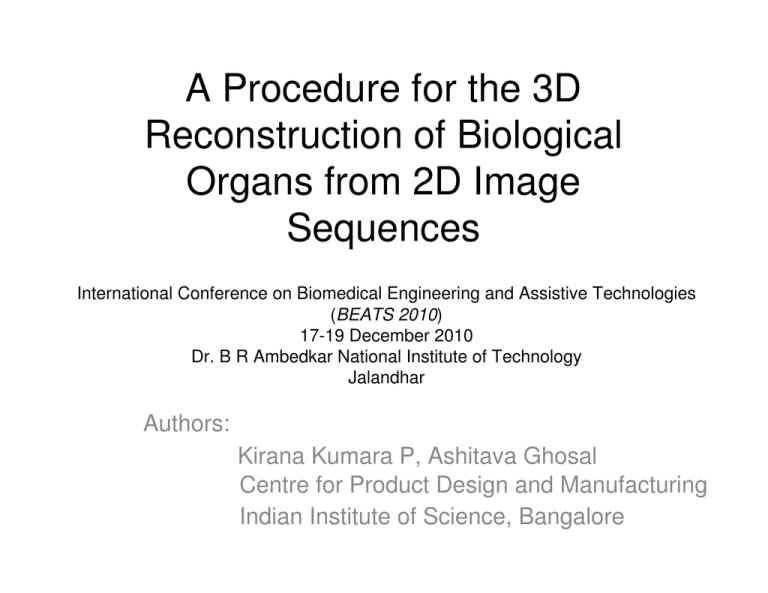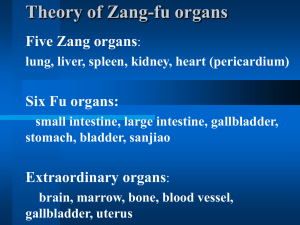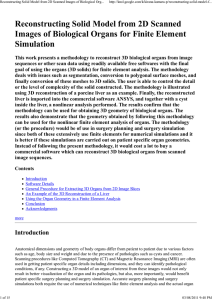A Procedure for the 3D Reconstruction of Biological Organs from 2D Image Sequences
advertisement

A Procedure for the 3D Reconstruction of Biological Organs from 2D Image Sequences International Conference on Biomedical Engineering and Assistive Technologies (BEATS 2010) 17-19 December 2010 Dr. B R Ambedkar National Institute of Technology Jalandhar Authors: Kirana Kumara P, Ashitava Ghosal Centre for Product Design and Manufacturing Indian Institute of Science, Bangalore Motivation • Simulating biological organs - Surgery planning - Surgery simulation • Need for 3D models of biological organs • Patient specific models • Organ simulations need numerical techniques like FEM Difficulties • 3D models of biological organs NOT readily downloadable from the internet! • Cost a few hundred dollars (approximate) • Also, not patient specific Get 3D models from 2D images obtained through CT-scan (patient specific, or archived) 2D images for the entire human body FREELY available for download (requires license) Popular software for extracting 3D models from 2D image sequences (FOR THE PRESENT PROBLEM) are NOT free! Downloadable (Demo) versions cannot Save Present Work Use multiple FREE software packages Utilize useful features from different software Different stages of reconstruction can use different software Necessary software packages: ImageJ, ITK-SNAP, MeshLab Example: Using ImageJ Porcine liver (from [14]) Original Image After Processing with ImageJ ITK-SNAP Segmentation I Segmentation II Segmentation III Segmentation IV (Images from ITK-SNAP documentation available from [8]) Control the Level of Detail in the Model: Use MeshLab Liver: 576376 Faces Liver: 2000 Faces Liver: 200 Faces Liver: 200 Faces (Well Shaped Triangles) FE Analysis The Liver (Undeformed + Deformed) Advantages • All software used are free • Can control the level of detail of the 3D model constructed • Surface meshes which describe the model are of good quality (model can be used for FE Analysis) Limitations • Multiple software need to be used • Maybe easier & more efficient to use a commercial software Possible Future Work • Source codes for all software are freely available; the codes may be used to build a free software comparable to a typical commercial software • Adding new useful features to the free software • Modify free software to make them more easy and more efficient to use References [1] http://www.3d-doctor.com [2] http://www2.amira.com [3] http://www.rhino3d.com [4] http://www.ansys.com/ [5] http://rsbweb.nih.gov/ij/ [6] Rasband, W.S., ImageJ, U. S. National Institutes of Health, Bethesda, Maryland, USA, http://rsb.info.nih.gov/ij/, 1997-2009. [7] Abramoff, M.D., Magelhaes, P.J., Ram, S.J., "Image Processing with ImageJ", Biophotonics International, Volume 11, issue 7, pp. 36-42, 2004. [8] http://www.itksnap.org [9] Paul A. Yushkevich, Joseph Piven, Heather Cody Hazlett, Rachel Gimpel Smith, Sean Ho, James C. Gee, and Guido Gerig, “User-guided 3D active contour segmentation of anatomical structures: Significantly improved efficiency and reliability”, Neuroimage, 2006 Jul 1;31(3):1116-28. [10] http://www.gnu.org/licenses/gpl.html [11] http://meshlab.sourceforge.net/ [12] MeshLab, Visual Computing Lab - ISTI – CNR [13] Oztireli, Guennebaud and Gross, “Feature Preserving Point Set Surfaces based on Non-Linear Kernel Regression”, Eurographics 2009 [14] http://biorobotics.harvard.edu [15] Amy Elizabeth Kerdok, Characterizing the Nonlinear Mechanical Response of Liver to Surgical Manipulation, Ph.D Thesis, The Division of Engineering and Applied Sciences, Harvard University, 2006. THANK YOU!





